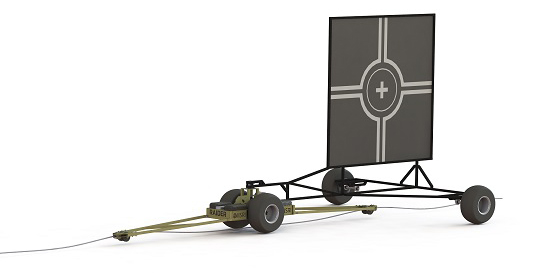OzBot Raider mobile target system to revolutionise safer defence training
Media releaseDeakin University has entered a partnership with RCR for the development of a world-first robotics-driven target system, for use by armed forces in training to enable better improve accuracy.
The unmanned tug-operated unit is being displayed by Deakin’s Institute for Intelligent Systems Research and Innovation (IISRI) at this week’s Australia’s Land Forces 2016 defence exhibition show in Adelaide.
The research engineers behind the unique technology, dubbed the OzBot Raider, will next month present the system to the Australian Army. The joint venture with RCR will enable the system to be commercialised globally, by allied forces.
IISRI Director Professor Nahavandi said the OzBot Raider was the latest innovation from Deakin’s long-term cutting-edge research designing systems to improve Australian Defence capabilities and technologies.
“The OzBot Raider will enable armed forces to undertake validation and compliance testing of weapons without risk to personnel or any compromise in scenario realism,” Professor Nahavandi said. This is a globally unique system that has potential to improve weapon accuracy, which will translate to increased effectiveness.”
The system is currently undergoing field trials and is expected to achieve full readiness in coming weeks. RCR CEO Dr Paul Dalgleish said he was excited about the development and commercialisation of the OzBot Raider and looked forward to a productive relationship with Deakin University.
“RCR has the financial, marketing and manufacturing capacity to work with Deakin University to take these robotic target systems to the defence marketplace,” Dr Dalgleish said.
“RCR is proud to be a high-tech Australian engineering firm which designs and manufactures equipment locally. We train and employ our own people to be highly skilled to produce world class equipment, so Target Bot and Oz Bot are exactly the sort or innovative products we are targeting.
In a further strengthening of Deakin’s ongoing relationship with the Australian Defence Force, the University recently appointed Professor Saeid Nahavandi as the nation’s first ever Pro Vice-Chancellor for Defence Technologies.
Professor Nahavandi said his focus would be to lead projects to bring together the Australian Defence Force, defence industry representatives and academics to sustainable contributions in the defence and security domains.
“Deakin is renowned for driving transformation and investment in advanced manufacturing and this new appointment signals the University’s understanding of the innovation challenges facing the nation and its allies in defence,” Professor Nahavandi said.
“My role will be to build on the key part Deakin has played in Defence development for more than three decades, which began with the post-graduate accreditation of Australian Army's Command and Staff College courses in the 1980s,” he said.
“Deakin was the first university to receive funding under the Capability and Technology Demonstrator program to design and develop a haptically enabled mobile robot, which is currently in use by a number of law enforcement agencies.
“Deakin has since been granted another Capability and Technology Demonstrator award in the field of Low-Cost High-G Centrifuge for pilot training.”
About OzBot Raider
- Modular design - allows a wide variety of targets, including simulated thermal or acoustic payloads, or panels lined with high-tech coatings;
- Can be configured to operate on a graded track and deployed within an hour to a new location;
- On-board sensors allow the speed and location of the target to be monitored or adjusted in real time and ensure that all runs are consistently performed to the defined test parameters;
- High-definition cameras mounted on both the tug and trailer provide operators with real-time view of the down-range operations and allow targeting accuracy to be assessed during or at the end of each run;
- Will provide local industry with job opportunities, as construction of the system leverages local suppliers and fabricators, with significant potential to be exported to allied countries around the world;
- Relatively low-cost system, can operate in GPS-denied areas, is battery powered with spare packs able to be charged from a standard power outlet or small generator, intrinsically safe, offers low heat generation and is its modular design allows for quick and easy in-field servicing;
- Use of a cable-guided self-driven tug greatly reduced the complexity of command and control demands, allowing both cost and complexity to be kept to a minimum;
- The tug uses a high-torque, high speed DC electric motor and it will follow any straight, graded path as defined by the guide cable while on-board sensors accurately monitor key system parameters and can automatically slow or halt the system if an error is detected;
- The target-trailer connects to the tug via a 360° rotating hitch, which allows the trailer to naturally swing around and follow the tug each time the tug changes direction;
- Unique design allows the tug to perform continuous runs back and forth without human intervention.
Share this story

